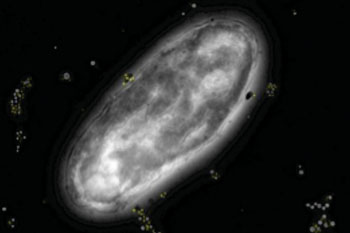Interaction of Gut Cells with Bacterial Outer Membrane Vesicles Triggers Inflammatory Bowel Disease in Mouse Model
By LabMedica International staff writers
Posted on 27 May 2015
Interaction of bacterial outer membrane vesicles (OMVs) harboring sulfatase activity with the cells lining the gut has been implicated as a key step in the development of inflammatory bowel diseases (IBDs) such as Crohn's disease and ulcerative colitis.Posted on 27 May 2015
Sulfatases are enzymes of the esterase class that catalyze the hydrolysis of sulfate esters. These moieties may be found on a range of substrates, including steroids, carbohydrates and proteins. Sulfatases play important roles in the cycling of sulfur in the environment, in the degradation of sulfated glycosaminoglycans and glycolipids in the lysosome, and in remodeling sulfated glycosaminoglycans in the extracellular space.

Image: Outer membrane vesicles released by Bacteroides thetaiotaomicron may help initiate inflammatory bowel disease (Photo courtesy of Wandy Beatty, Washington University School of Medicine).
Investigators at the Washington University School of Medicine (St. Louis, MO, USA) worked with a genetically engineered mouse model (dnKO) that developed spontaneous, fulminant colitis when triggered by the Gram-negative, obligatory anaerobic bacterium Bacteroides thetaiotaomicron.
Results published in the May 13, 2015, issue of the journal Cell Host & Microbe revealed that B. thetaiotaomicron antigens localized to host immune cells through outer membrane vesicles (OMVs) that harbored bacterial sulfatase activity. Access of B. thetaiotaomicron OMVs to host immune cells was sulfatase dependent.
OMVs are a means for bacteria to communicate among themselves and with other living forms in their environment via nanoscale membrane vesicles in their outer membranes. These vesicles are involved in trafficking bacterial cell signaling biochemicals, which may include DNA, RNA, proteins, endotoxins, and allied virulence molecules.
The investigators deleted the anaerobic sulfatase maturating enzyme (anSME), which is required for post-translational activation of all sulfatase enzymes, from B. thetaiotaomicron. This bacterial mutant strain did not stimulate colitis in dnKO mice.
"The immune cells do not need to encounter the bacteria to cause inflammation—all they need to do is encounter the vesicles," said senior author Dr. Thad Stappenbeck, professor of pathology and immunology at the Washington University School of Medicine. "We did not realize that was possible, and we think this discovery could change our thinking about not just IBD but other autoimmune disorders and infectious diseases."
Related Links:
Washington University School of Medicine













